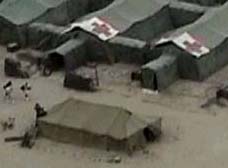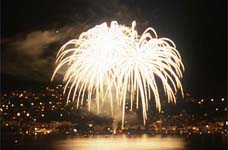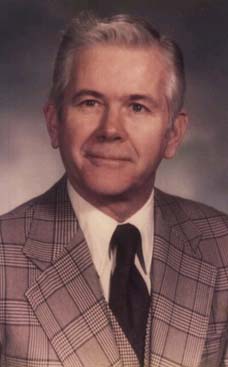
In case you are thinking that Rosenberger is reminiscing about the good old days, he's hardly an old-timer. He graduated from Homestead High School in 1983, then went on to study natural resources at the University of Wisconsin-Stevens Point. From there he and his wife, Suzette, joined the Peace Corps for two years, working in Burundi in eastern Africa, near Rwanda. There he worked with residents on a fish project that introduced a new source of protein into the diets of area residents.
Burundi RPCV Robert Rosenberger lives in a log cabin he he built with his wife and two children
Logs bring year-round warmth
Cabin near Crivitz has an all-natural feel
Posted: Sept. 3, 2005
It might seem a long way, both geographically and philosophically, from growing up in Mequon to living in a log cabin just outside Crivitz.
While the path may have been circuitous for Robert Rosenberger, it was more logical than you might think.
"I grew up in the more northern and western part of Mequon that was, and still is, much more open than the eastern part," says Rosenberger, a decoy artist who will display his work at the upcoming Harvest of Art and Crafts, planned Sept. 10 and 11 by the Milwaukee County Historical Society.
"When I was younger, I could grab my shotgun and go pheasant hunting after school," he says. "I remember going to school once after being sprayed by a skunk."
In case you are thinking that Rosenberger is reminiscing about the good old days, he's hardly an old-timer. He graduated from Homestead High School in 1983, then went on to study natural resources at the University of Wisconsin-Stevens Point. From there he and his wife, Suzette, joined the Peace Corps for two years, working in Burundi in eastern Africa, near Rwanda. There he worked with residents on a fish project that introduced a new source of protein into the diets of area residents.
"They were hard-working, stoic people," he says. "Their annual income typically would be about $130 a year," he says. "For the farmers selected to work on the project, the new source of income could increase that by a third."
The work was difficult, but extremely rewarding. "You give as much as you can," he says of his time in Burundi. "But you still get more back."
After returning to Wisconsin, Rosenberger began working for the Department of Natural Resources, eventually winding up in the Peshtigo office. There he combines his love of nature and the outdoors with his career, specifically working with landowners who are interested in doing projects in or near lakes, rivers and wetlands. He helps make sure the area waterfowl habitats will be protected.
His art also reflects those loves.
He subscribes to both schools of carving: producing some decoys that are very detailed and true to life; and others that are more primitive, styled after decoys that would actually be put in the water.
"The first style is more technical," he says. "I take measurements to make sure the proportions are absolutely accurate, whether for mergansers, wigeons, pintails. The other style is more free-form."
His home, too, reflects his love of the outdoors. He owns 240 acres in a town called Middle Inlet, north of Crivitz. After buying the property, he first built a sauna.
"I figured I would start smaller, and if I could do that, I could build a house," he says.
The planning went into full swing and eventually a 10-foot-tall pile of logs, 60 feet long, was delivered.
"They were delivered in the winter time and I remember looking at it and thinking, 'that's going to be my house,' " he says. Rosenberger set to work.
"The blueprint told me how many logs of each size I needed," he explains. "Some are 40 feet, some are shorter. Originally the logs would have been hand hewn with an ax, but I couldn't do that. I hired a guy with a portable sawmill and he set up on the property. I used a chain saw for the dovetail angles. I set many of the logs myself, dragging them up from the pile with my truck."
He had help, too, from friends and family.
Because log homes tend to shrink and settle, he designed the home with about a 4-inch allowance so that it can slide without causing damage.
"I also created a post that is separated so that I can lower the beam by turning the nut on a threaded bolt," he says. "I've heard horror stories of log homes settling and crushing windows. That won't happen here."
The home is both sound and attractive. The master bedroom is on the first floor, along with the living room, a bathroom and an oversize kitchen and dining area. Rosenberger's decoys are perched atop the exposed beam in the living room.
The second floor includes a bedroom for their daughter, Claire, and son, Frederick, as well as a second bathroom.
Because of its log construction, the home looks old, as if it has always been on the rolling land. Inside, it is appropriately filled with many old family pieces and antiques.
Rosenberger and Entrée editor Nancy Herrick sat and talked at the kitchen table talking one recent Sunday afternoon. From time to time Frederick came in, at one point showing us the black and white baby rabbits that were nestled in his cupped hands. Rosenberger seemed to enjoy talking about his art, his home and his family's rustic, though comfortable, lifestyle.
Q. How long have you lived here?
A. We have lived in this area since 1992. After buying the land, we lived in a mobile home on it, which made it easy to come home from work and get to work on the house. We built it seven years ago from a blueprint from a log home company. It has more than 1,800 square feet with three bedrooms and two bathrooms. I did it in the square-hewn, dovetail notch style. The logs are from the Nicolet National Forest.
Q. Was it a customized plan?
A. We did some adaptations to the plan: a mud room instead of a third porch, for example. And we built the kitchen with a cathedral ceiling instead of a flat ceiling.
Q. What were your goals in planning the house?
A. I always wanted to build a log cabin and live in a house like this. My family has a small log cabin on an island in Michigan, and it always has been a special part of my life. I did a lot of research, a lot of reading before we decided what to build. I like the flat walls of this home. It's the same style you would find in Door County homes.
Q. Why did you decide to build here.
A. My office is in Peshtigo, about a half-hour away. I started working full time for the DNR and bought the land in anticipation of building a home. It's wooded, but not on a lake. I saw the realities of lake living and this is more private than that. Plus, I wanted to have lots of land.
Q. Your home is very comfortable. Tell me about your decorating style.
A. We have lots of family heirlooms mixed with things we brought back from Africa - baskets, beaded pieces. We also have some early American rustic pieces that work well with the wood floor, wood stove.
Q. You have two porches and large windows. What role does light play?
A. Log homes usually have large overhangs. If you don't have a lot of windows, you can feel as if you are living in a cave. We used Pella windows, which are very energy efficient. That's important to me. The house also is very energy efficient. In winter, it takes awhile to heat up but stays warm. We heat the whole house with one wood-burning stove, using about 20 trees a year from our own property. We use our furnace only as a backup. In summer we open the windows at night and the house stays cool.
Q. Where have you found some of the special things for your house?
A. Some pieces are from auctions, some from Maxwell Street Days. We've bought old pieces and have stripped and refinished them. Low-maintenance is important to me. I always keep that in mind.
Q. Where do you spend most of your time when you are here?
A. In the kitchen. It is the main gathering area for our family. It is nice and warm in the winter because the wood stove is here. That's just what kitchens should be. We spend time on the back porch, too. We can see deer, bear, a wolf from time to time. We also like watching birds and they come right up to the house to feed.
Q. Where do you do your artwork?
A. I do the carving outside in the workshop that is in a separate building closer to the road. It was the previous owner's deer hunting shack. Then I do my painting at the kitchen table. I guess I'm busy all the time. I'm not the kind of person who just sits around.
Q. How did you become interested in carving?
A. I've had a special fascination with it since I was about 12. I would go to the Milwaukee River in Thiensville and just look at the ducks, study them. I carved a decoy to give to my dad when I was very young. I propped it up on a fence rail and shot it. I guess I wanted that authentic look.
I started carving more seriously in college and made a set of decoys for hunting. They were so heavy. My friends would laugh about this bag of decoys I had. They must have weighed 200, 300 pounds.
As I got older I would prioritize my time when I could so that I would have time for my carving. I would experiment a lot and drove myself to get better and better. Finally I took my first class and it opened a door for me. To go from being self-taught and doing it alone to learning from one of the best, it was amazing.
But I'm still learning a lot, especially about paint and highlights and shadows. There are so many colors just in a mallard's head.
My job with the DNR is working with land owners who really want to do the right thing when it comes to protecting shorelines and habitats. But then, when I get home, I can work on something also that is very creative. It all contributes to my appreciation of nature.










